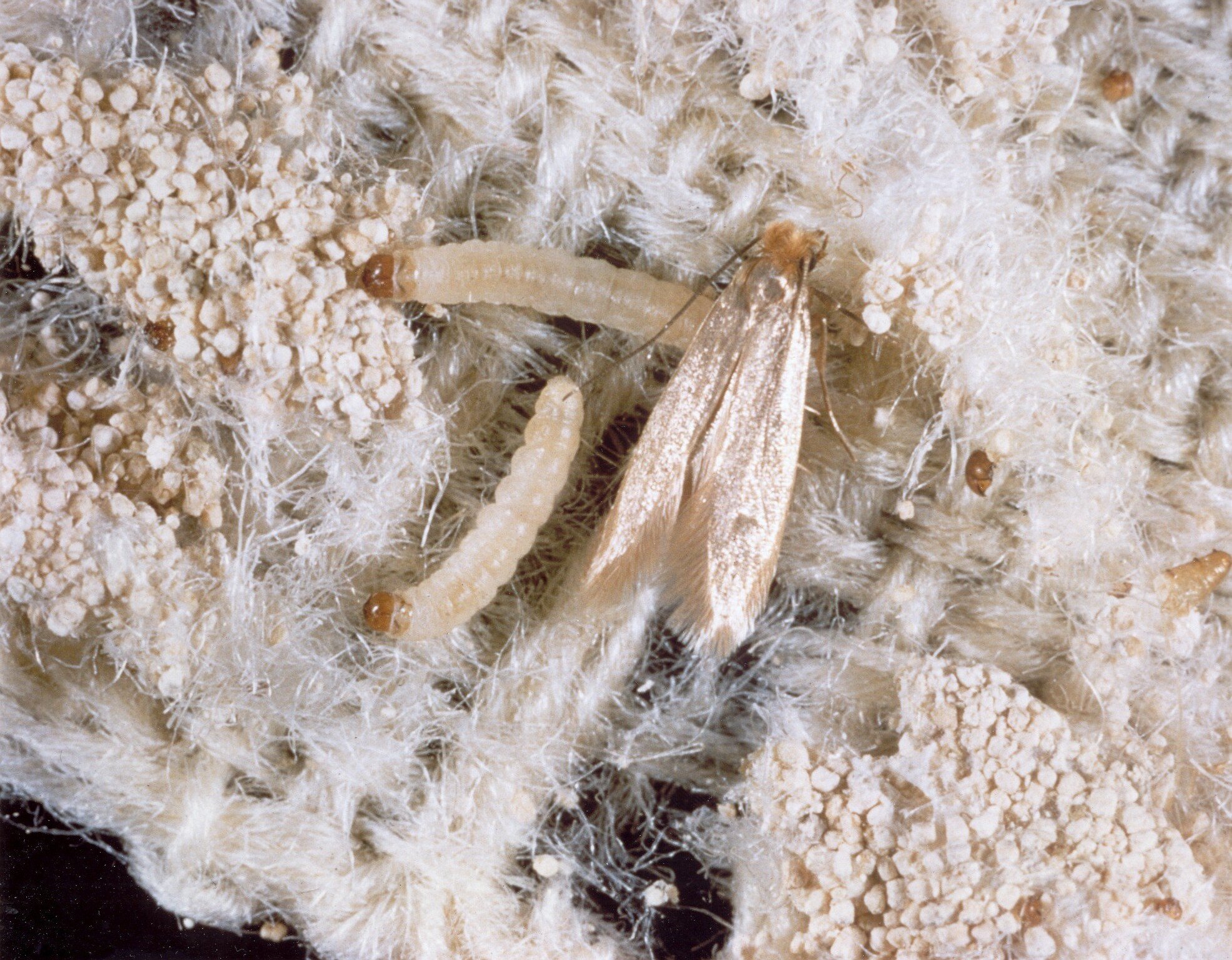Clothes Moths
The team of entomologists at Insects Limited has studied clothes moths for many years. Their research has shown that the female clothes moth will mate and will become heavy with fertilized eggs within the first 24 hours after emerging from her cocoon. Because of this, she will spend the majority of her time on a flat surface like the floor or a shelf. The male moth on the other hand will often be found fluttering around the closet or room in search of a female clothes moth.
Managing Clothes Moths in the Home
Capturing the female moth is important when trapping clothes moths. For every female trapped, this could reduce 50-100 fertile eggs from your home.
This is why it is important to place one GreenWay trap on the floor and one on the shelf in the closet or room where wool, fur or other natural fibers are stored.
Traps should be replaced every 2 months or when the trap is full. Each pheromone lure is active for 7-9 weeks after opening. Before opening the lure package, store it in a cool, dry area.
GreenWay products are non-toxic and trap insects without the use of pesticides.
About Clothes Moths
With the decreased use of moth-proofing, the incidence of clothing and rugs damaged by the clothes moth has increased significantly in recent years. Fabrics injured by clothes moths have holes eaten through them by small, white larvae. Materials left undisturbed for some time or stored in dark places (such as a closet, attic, or drawer) are most severely injured by these insects. The adults are small and champagne-colored. They can often be seen running over the surface of the infested goods when exposed to light or flying somewhat aimlessly about homes or closets.
Identification
Size: 1/4 inch to 3/8 inch (7-10 mm) in length with a wingspread of about 3/8 inch (10 mm)
Color – Adult: Clothes moths are small, buff, or brown colored insects, with narrow wings fringed with hairs.
Color – Larva: The larva is whitish colored with a brown or blackhead.
Life History, Food & Signs of Infestations
Insect Lifestyle: Generally, developmental time for the clothes moth from egg to adult in room temperature with a good food source is approximately 45 days. Mating and egg-laying begin almost immediately after adults emerge from the cocoon. Adult moths do not feed and die within one month. Female moths can lay more than 50 small, pin-head size, white eggs on or near the fabric, clothing, or furnishing they infest.
Food & Feeding: Clothes moth larvae feed on woolens, mohair, feathers, fur, hair, leather, dead insects, and dried animal carcasses. Infestations occur in clothing, carpets, rugs, furs, fabrics, blankets, stored wool products, upholstery, mounted animals, piano felts, fish meal, milk powder, and brush bristles. The caterpillar may feed on fabrics of vegetable origin or synthetics if the fabrics are mixed with wool, or may use such materials to construct their cocoons. Synthetics, cotton, and other plant materials are not attacked by the webbing clothes moth larvae unless these items are stained with food or body oils or in direct contact with other woolens or natural animal fibers. Although synthetics may be ingested, they cannot be digested.
Signs of infestation: A clothes moth infestation is often detected by holes in fabrics and by the presence of larval cases and webbing.
Clothes Moth Management
The key to eliminating clothes moth infestations is to interrupt the clothes moth life cycle. The damaging larval stage cannot be caught in moth traps but can be eliminated via other means. The following list represents the current best practices of a moth removal program.
Heat
Clothes moth larvae and eggs can be quickly killed with high heat. Placing garments on hangers in a closed-up car on a very hot, sunny day (85°F) for 4 hours will eradicate the immature stages. Hanging garments in black plastic bags and hanging in direct sunlight on a hot day can achieve the same results.
Smaller items like woolen socks, mittens, scarves, hats and sweaters can be placed in a tumble dryer (without washing) and exposed to the heat on a high setting for 30 minutes.
Larger items like rugs can be placed over the porch banisters and exposed to the direct sun for a couple of hours then turned over so that all sides get exposed. Beating these rugs will also help dislodge eggs and larvae from the base of the fibers.
Cold
Clothes moth larvae and eggs can also be killed with long exposure to freezing temperatures. Items that you wish to freeze can be placed in GreenWay Freezer Treatment Bags. The bag should be placed in the freezer for a minimum of 7 days.
Cold Storage
A good solution for Spring to Fall storage of furs is to use a cold storage service at a professional furrier or fur store.
Dry Cleaning
Expensive woolen jackets, uniforms, dresses, slacks, and garments with ‘dry clean only’ labels should be taken to the dry cleaner.
Steam Cleaning
Upholstered furniture and carpets can be cleaned using a steam cleaner. The hot steam will kill eggs and larvae on contact. Note: Steam will not penetrate through thick, > ½ inch wool rugs/carpeting/padding. Eggs and larvae on the underside of these floor coverings may survive if that area is not also treated.
Professional Cleaning
Large rugs should be taken out and cleaned by a professional service. They can put these rugs into large pools with cleaners, have them washed, dried, and repaired if damaged. They can provide a thorough job with less effort than attempting to use just a steam cleaner and vacuum.
Damaged or dirty furs should be cleaned by a furrier or fur store with this service. They have the proper cleaning agents and drying equipment to remove perspiration and other spills on the hair and fabric.
Brushing
Some garments or rugs may show signs of damage (webbing or granular debris). This may be simply removed with a fine brush. This is an important step after freezing or heating garments to remove debris. If the garment is damaged in the future, new damage will be evident compared to old damage.
Vacuuming
Regular vacuuming of the carpets and rugs including under furniture can help remove eggs and larvae over time. This keeps the population from accumulating and reduces the chances of damage. A crack and crevice tool to clean out the gaps around the edges of the rooms is extremely effective.
Maintaining the Program
Best Practices
Following certain procedures can dramatically reduce the chances of getting an infestation of clothes moths in your residence. These procedures are called “Best Practices” in preventing clothes moth activity. All these procedures reduce moth-conducive conditions and eliminate the need for toxic pesticides. These Best Practices include:
Sanitation - Removing conducive elements.
Cleaning and/or removing unused or seldom used clothing that contains animal fibers
Removing or cleaning other clothes moth food sources in residential or storage areas.
Detailed vacuuming of living and storage spaces to remove pet hair, human hair and dead insects that can become a food source for clothes moths. Note: Vacuum bags containing hair and dander should be replaced every 2 months to prevent the contents from becoming a source of the moths.
Large wool rugs can be professionally cleaned, smaller rugs can be taken outdoors and “beaten” until no further dust emerges.
Areas beneath furniture and beds should be thoroughly cleaned of dust and debris. Pay attention to the area where the furniture legs encounter a wool rug or wool carpeting.
Exclusion - Preventing moth entry.
Sealing off any cracks or passageways that lead from another residence to your residence.
Installing door sweeps to prevent moth entry beneath or along the vertical portions of doors into common areas.
Making sure that good quality insect screens are installed prior to opening any windows to the outdoors.
Sealing off any gaps around windows that may allow moths to enter.
Storing cleaned wool or fur garments in specialized moth-resistant garment bags or in well-sealed sweater boxes
Annually check all moth prevention methods and as a part of on-going maintenance
Monitoring - Determining moth populations.
Sticky traps baited with the sex pheromone of clothes moths is the single best way to monitor for the presence of these moths. Make sure that the pheromone lure quality is high and coming from a reputable company.
Visual monitoring in front of television or computer screens during the evening hours can indicate the presence of moths in a residence.
Inspection - Locating sources of moth infestation.
The number of moths captured in a pheromone monitoring trap can help give direction of where to inspect for the presence of the damaging moth larvae. If several traps have been placed in a single residence, the traps that contain the most moths over a set time are generally the closest to the source of a moth infestation.
Inspection should first focus on areas containing the highest risk materials. These materials will be the most likely to harbor a moth infestation.
Check for the presence of moth larvae, light trails of moth webbing (silken strands) and frass (larval feces) directly on those high-risk materials.
Actively infested materials should be sealed off (if they can be sealed off) and removed or treated to kill the moth population. Larger items, like furniture and large area rugs should be covered in plastic sheeting and removed or treated in-place.


